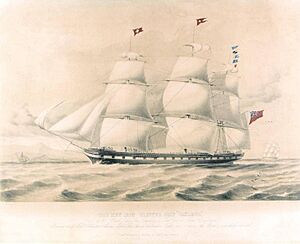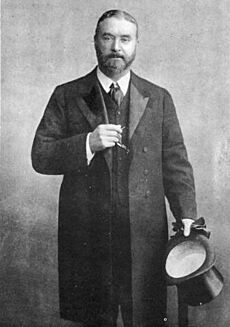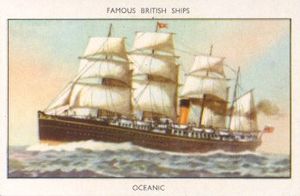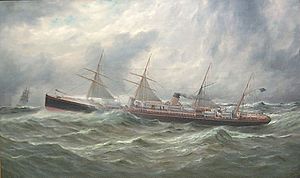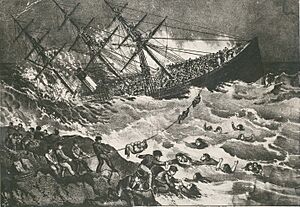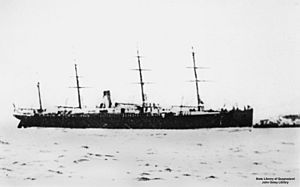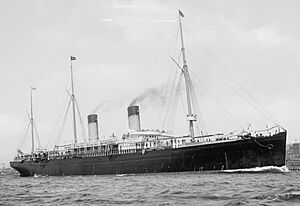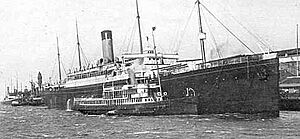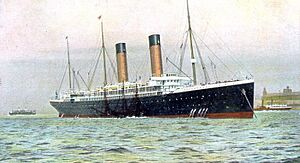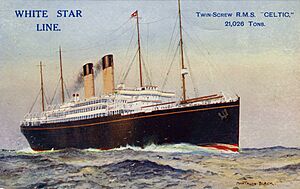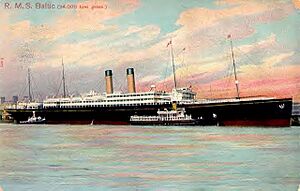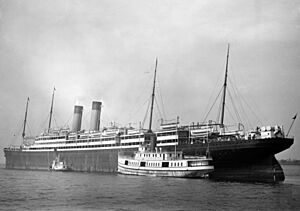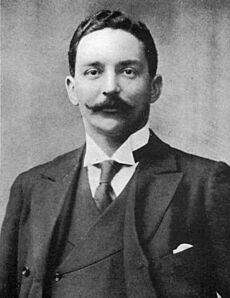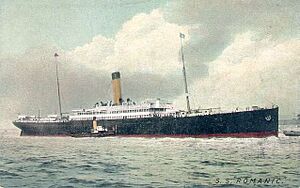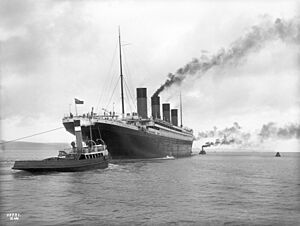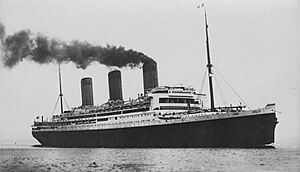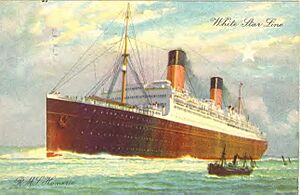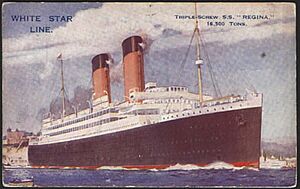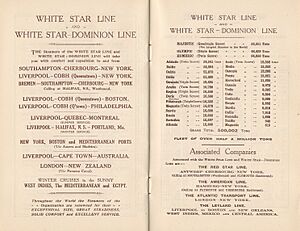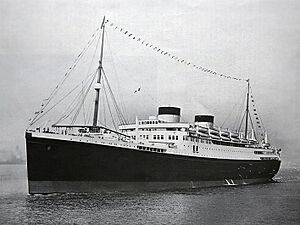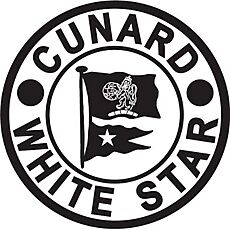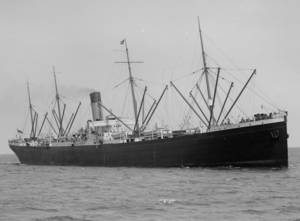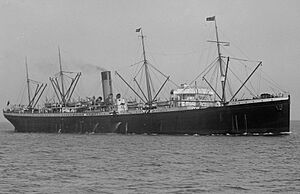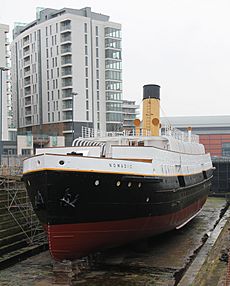White Star Line facts for kids
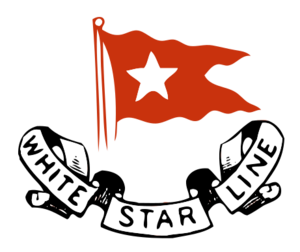 |
|
| Partnership | |
| Industry | Shipping, transport |
| Fate | Merged with Cunard Line |
| Successor | Cunard White Star Line |
| Founded | 1845 in Liverpool, England |
| Defunct | 1934 |
|
Area served
|
Transatlantic |
| Parent | Ismay, Imrie and Co. |
Footnotes / references House Flag |
|
The White Star Line was a famous British shipping line. It started from a company that had closed down. Over time, it grew into one of the most important shipping companies in the world. It carried passengers and goods between the British Empire and the United States. While some companies focused on speed, White Star Line was known for making journeys comfortable. This was true for both rich travelers and immigrants.
Today, the White Star Line is remembered for its amazing ship, Oceanic. It is also known for losing some of its best passenger ships. These include the Atlantic in 1873, the Republic in 1909, the loss of Titanic in 1912, and the Britannic in 1916 during wartime. Even with these losses, the company stayed strong in the shipping world. But it faced problems during the Great Depression. In 1934, White Star Line joined with its main competitor, the Cunard Line. They became Cunard-White Star Line. Cunard later bought White Star's share in 1950. Today, modern Cunard ships still use "White Star Service" to describe their excellent customer care.
| Top - 0-9 A B C D E F G H I J K L M N O P Q R S T U V W X Y Z |
The Early Years (1845–1868)
The first company called White Star Line began in Liverpool, England, in 1845. It was started by John Pilkington and Henry Wilson. They focused on shipping between the UK and Australia. This route became very busy after gold was found in Australia in 1851. Many people wanted to move to Australia then.
Pilkington and Wilson always told the public that their ships were safe. To make trips more fun on these simple wooden ships, they even hired musicians. Speed and size became very important for their ships. Their first ships included the Tayleur, Blue Jacket, and Red Jacket.
The Tayleur was the biggest ship of its time. Everyone had high hopes for it. But on its first trip in January 1854, the Tayleur was hard to control. Its crew was also new. It hit rocks in a bad storm near Lambay Island, Ireland, and sank. Only 290 of the 650 people on board survived. An investigation blamed the ship's owners for not taking enough safety steps. The White Star Line and the captain were found not guilty.
To make up for the Tayleur loss, the company ordered more ships. The Red Jacket was very good on the Australia route. This helped the company get new, faster ships like Shalimar and Sultana. The company also started trips from Liverpool to Victoria, British Columbia. They advertised this as the way to the Klondike Gold Rush.
In 1856, the company lost its mail contracts. Henry Wilson wanted even bigger ships, but Pilkington disagreed and left. Wilson then brought in his brother-in-law, James Chambers. The company kept using sailing ships. In 1863, they bought their first steamship, the Royal Standard.
The original White Star Line joined with two other small companies in 1864. They formed a bigger group. But Wilson kept borrowing a lot of money for new ships, including their second steamer, Sirius. Chambers got worried and left. The company's bank failed in 1867. White Star Line was left with a huge debt and went bankrupt.
On January 18, 1868, Thomas Henry Ismay bought the White Star Line's name and good reputation. He paid £1,000 for it. He planned to run large steamships between Liverpool and New York. Ismay set up the company's main office in Albion House, Liverpool.
A merchant named Gustav Christian Schwabe and his nephew, Gustav Wilhelm Wolff, met Ismay. Schwabe offered to pay for the new shipping line. But only if Ismay had his ships built by Wolff's company, Harland and Wolff. Ismay agreed, and they formed a partnership. Harland and Wolff would build the ships for a set price. They also promised not to build ships for White Star's rivals. In 1870, William Imrie joined the company.
Ismay officially started the new White Star Line. It had a lot of money, £400,000, divided into shares. The company was managed by Ismay, Imrie and Company. But everyone still knew it as the White Star Line. Ismay wanted to be a leader on the busy route between Liverpool and New York.
First Transatlantic Journeys (1868–1874)
The Oceanic Class Ships
White Star Line started its trips between Liverpool and New York with six similar ships. These were called the Oceanic class. Their names were Oceanic, Atlantic, Baltic, Republic, Celtic, and Adriatic. White Star Line decided to name all its ships with names ending in -ic.
The company also chose a special look for its ships. They had a buff-colored (light brown) funnel with a black top. Their house flag was a red flag with a white five-pointed star.
These first ships were about 420 feet long. They could go up to 14 knots (about 16 miles per hour). They had space for 166 first-class passengers and 1,000 steerage (economy) passengers.
White Star Line wanted to be known for treating steerage passengers well. They often offered better conditions than other companies. On the Oceanic class ships, single men were in the front. Single women and families were in the back. This was a big improvement for immigrants.
White Star's first trip in 1871 had a rough start. The Oceanic left Liverpool with only 64 passengers. It had to turn back for repairs because its engine got too hot. But when it finally reached New York, about 50,000 people came to see it! The Oceanic's second trip was much better.
Over the next 18 months, the other five ships were finished. They joined the route to New York. The names of two ships, Pacific and Arctic, were changed. This was because two old ships with those names had sunk with many lives lost. So, Pacific became Baltic, and Arctic became Celtic.
The Adriatic and Celtic were built a bit longer than the others. The Adriatic became the first White Star ship to win the Blue Riband. This award was for the fastest trip across the Atlantic. It crossed in 7 days, 23 hours, and 17 minutes. Later, the Baltic won the Blue Riband for the fastest eastbound trip.
Problems and a Big Disaster
White Star Line also tried routes to other places, like India and South America. But these routes were not very profitable.
The company faced its first major disaster in 1873. The RMS Atlantic sank near Halifax, Nova Scotia. It was sailing to New York in a bad storm. The crew thought they might run out of coal. So, they tried to go to Halifax. But the ship hit rocks and sank in shallow water.
Even though it was close to shore, 535 of the 952 people on board died. White Star was accused of not putting enough coal on the ship. The captain was blamed for making bad decisions. A Canadian investigation blamed the crew for navigation errors. But a British investigation said the company was not fully to blame.
The Atlantic disaster was not forgotten. Thomas Ismay personally helped pay for the victims' graves. In 1915, the company helped build a monument for them. To keep the company financially healthy, two ships, Asiatic and Tropic, were sold right away.
New Ships and New Routes (1874–1899)
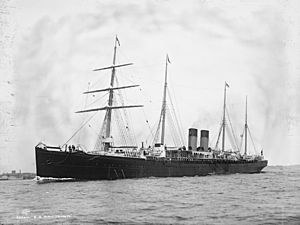
After the Atlantic disaster, White Star Line kept growing on the North Atlantic route. But other companies were building bigger ships. So, White Star ordered two new, larger ships from Harland & Wolff. These were the Britannic and Germanic (1874). They were nearly 5,000 tons and could carry more passengers.
The Britannic started its first trip in June 1874. The Germanic followed in May 1875. With these new ships, the original Oceanic was no longer needed on the Atlantic route. It was sent to work on a route between San Francisco, Yokohama, and Hong Kong.
The Britannic and Germanic were very popular. Both ships won the Blue Riband for fastest Atlantic crossings multiple times. In 1877, White Star Line started sharing a mail contract with Cunard Line. This meant their ships could use the 'RMS' (Royal Mail Ship) prefix.
Pacific and Indian Oceans
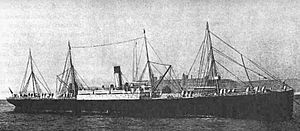
With new ships on the Atlantic, White Star had extra ships. They lent some, like the Oceanic, to the Occidental and Oriental Steamship Company. This company competed on the Pacific route. The Oceanic stayed on the San Francisco – Hong Kong route for 20 years. This partnership lasted until 1906.
In 1882, the Shaw, Savill & Albion Line started a route to New Zealand. White Star Line joined them in 1884. White Star provided ships like the Coptic, Doric, and Ionic. These ships stopped in Australia on the way out and used the Panama Canal on the way back. This joint service continued for many years. Even after White Star Line disappeared, Shaw Savill & Albion Line kept naming their ships with -ic.
White Star also started using new cargo ships to carry live cattle. The first was the Cufic in 1888. Others followed, like the Bovic and Naronic. The Naronic mysteriously disappeared less than a year after its first trip.
Teutonic and Majestic
For the next 12 years, White Star Line focused on other things. They added more cargo and livestock ships. They also started a profitable passenger service to New Zealand. By 1887, their older ships like Britannic and Germanic were getting old. Newer ships from rivals were faster and more comfortable.
To compete, White Star planned two very new and special ships: the Teutonic and Majestic. Thomas Ismay made a deal with the British Government. The government would help pay for the ships. In return, the ships would be built to also serve as warships if needed.
These new ships were much bigger, nearly twice the size of Britannic and Germanic. They were the first White Star ships with two propellers. They could go up to 19 knots (about 22 miles per hour).
The Teutonic and Majestic had space for 1,490 passengers in three classes. First Class was in the middle of the ship, where it was most comfortable. Second Class was behind First Class. Third Class was at the front and back, where the motion of the ship was felt more. These were the first White Star ships to use a three-class system.
Construction started in 1887. The Teutonic was launched in January 1889 and began trips in August. The Majestic was launched in June 1889 and started service in April 1890. Before its first trip, the Teutonic was shown at a big Naval Review. Even the German Emperor, Kaiser Wilhelm II, was impressed!
These ships were White Star's last to break speed records. In 1891, both ships won the Blue Riband. The Majestic set a new westbound record. Then the Teutonic beat that record just two weeks later.
With these new ships, White Star sold some of its older ones. The Baltic and Republic were sold to another company. The Celtic was sold to a Danish company.
Cymric and the Shift to Comfort
In the late 1890s, White Star Line grew quickly. They started focusing on building the most comfortable and luxurious ships, not just the fastest. Their first step in this new direction was the Cymric in 1897.
The Cymric was first planned as a ship to carry both passengers and livestock. But they decided it would be better to only carry passengers. So, they changed the design to add more Third Class cabins. It also had space for 258 First Class passengers.
The Cymric was an example of a new era for ocean liners. These ships focused on a more luxurious experience. An ocean liner was like a small city. People from all walks of life traveled on it. Everyone got the same basic service: a trip to their destination.
The Cymric was the largest ship in the White Star fleet at the time. It was over 13,000 tons and 585 feet long. It looked more like a cargo ship with one funnel and four masts. It was considered the first of White Star's "intermediate" liners.
Because it was designed for cargo, its engines were smaller. They used less coal and took up less space. This left more room for passengers and crew. It was also more economical to run. The Cymric was launched in October 1897 and started service in February 1898. It became a popular and profitable ship.
Oceanic and Thomas Ismay's Death
In 1897, Thomas Ismay and other White Star officials realized they needed a new, big ship. Their fleet was falling behind rivals like Cunard. The original Adriatic was 25 years old. Even Teutonic and Majestic were now outdone by newer ships.
Ismay and Harland & Wolff planned two new liners. They would be the largest and most luxurious ships ever built. They were to be named Oceanic and Olympic.
Construction of the Oceanic began in March 1897. It was so big that work was delayed until a special crane could be built. Its launch in January 1899 was a huge event, with over 50,000 people watching. The Oceanic was the last British transatlantic liner launched in the 19th century. It was also the first to be longer than the famous Great Eastern.
The Oceanic was 704 feet long and over 17,000 tons. It was 42% larger than its biggest rival. Like Teutonic and Majestic, it could be turned into an armed merchant cruiser in wartime. It had space for over 1,700 passengers.
The Oceanic started its first trip from Liverpool on September 6, 1899. It arrived in New York to much excitement. Many passengers were happy with the journey.
Sadly, Thomas Ismay did not get to enjoy his success for long. A few weeks after Oceanic was launched, his health got worse. Plans for the second ship, Olympic, were put on hold. Ismay visited Oceanic in July and was honored for his work. But his health declined quickly. He died on November 23, 1899, at age 62. His son, Bruce Ismay, took over the company.
International Mercantile Marine Co. (1899–1914)
The Boer War and the Big Four
After Thomas Ismay's death, his oldest son, Bruce, took charge. The company soon became involved in the Second Boer War. Many of its ships were used for the war effort. This included the cargo ship Nomadic and the Britannic. In total, ten White Star ships helped transport soldiers and animals.
Even before the Oceanic was finished, White Star planned an even bigger ship. In September 1898, Thomas Ismay ordered the last passenger liner he would ever choose. It would be called Celtic (1901), reusing a name from an earlier ship. The Celtic was designed to be 680 feet long and over 20,000 tons. It would be the largest ship in the world by weight.
Engines and Design
The new Celtic was designed to be very efficient. Its engines were like those on the Cymric. They were smaller and used less coal than the Oceanic's engines. This made the Celtic much more economical to run. It could also carry a huge amount of cargo, up to 18,500 tons. This cargo helped keep the ship steady in rough seas.
Passenger Capacity
The Celtic was designed to carry a lot of passengers and cargo. It could hold 2,859 passengers: 347 in First Class, 160 in Second Class, and 2,352 in Third Class. This was the largest Third Class capacity on any ship at the time.
First Class areas were in the middle of the ship. They included a lounge, smoke room, and a large dining room. Second Class had its own smoke room and library.
What made Celtic special was its Third Class. It had plenty of open deck space. Most sleeping areas were two, four, or six-berth cabins. This was a big change from the older style of large rooms with 20 or more people. Single men were still in the front, and families in the back.
Construction of the Big Four
Construction of the Celtic began in March 1899. It was launched in April 1901 and was the largest ship in the world by tonnage. It was known for being very stable, "as steady as the Rock of Gibraltar."
The second ship, Cedric, was launched in August 1902. It was slightly heavier than the Celtic, making it the new largest ship in the world. The Cedric had more private bathrooms and suites for First Class passengers. It started service in February 1903.
The third ship, Baltic, started construction in June 1902. White Star decided to make it 28 feet longer while it was being built. This added more space for passengers. The Baltic could carry 2,850 passengers and was even larger than the Cedric. It became the new largest ship in the world. It was launched in November 1903 and began service in June 1904.
The fourth and final ship, Adriatic, had a long delay in its building. It took almost four years to build, more than twice as long as its sisters. It was launched in September 1906. The Adriatic was known for its luxurious interiors. It was the first liner to have a Turkish bath and a swimming pool on board.
Joining J.P. Morgan's Trust
As White Star built its "Big Four" ships, it also bought smaller ships. In 1903, they got five new liners, including Arabic.
In 1902, the White Star Line was bought by the International Mercantile Marine Co. (IMM). This company was owned by the American banker John Pierpont Morgan. Morgan wanted to control all shipping on the North Atlantic. He bought several shipping companies, and White Star Line was his biggest purchase.
Morgan offered White Star's owners a lot of money. The Ismay family was hesitant at first. They knew Thomas Ismay would have been against it. But Bruce Ismay and the other owners finally agreed. Bruce Ismay later became the president of IMM.
Intermediate Liners and Growth
After the IMM takeover, White Star gained four more ships in 1903. These ships, like the Columbus and Commonwealth, had belonged to the Dominion Line. They were renamed Republic, Cretic, Romanic, and Canopic. These ships were similar in size and speed to the Cymric.
The Republic became known as 'The Millionaires' Ship'. It had space for 2,400 passengers. The other three ships had smaller capacities. These ships were used on routes to Boston and the Mediterranean.
In 1907, White Star started a new "Express" service to New York from Southampton. Ships would stop at Cherbourg, France, and then Queenstown, Ireland. Southampton was closer to London, which saved travel time. This new route was maintained by Teutonic, Majestic, Oceanic, and the new Adriatic.
Olympic-Class Ships
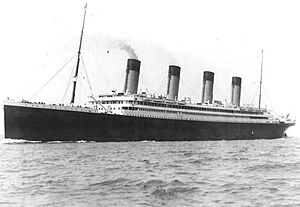
White Star moved its main service to Southampton in 1907. This allowed them to pick up more passengers in France. But this was only a temporary solution. The company was already planning much larger and faster ships. These would be the famous Olympic-class liners.
While Harland & Wolff built the new Olympic class ships, White Star continued to expand. In 1909, White Star took over some routes to Canada. Two ships, Laurentic and Megantic, were transferred to White Star. These ships also helped test new engine designs for the Olympic-class ships.
When Olympic started service in June 1911, it was a huge success. White Star ordered a third ship, Britannic. But the success was soon interrupted. On September 20, 1911, the Olympic crashed into a cruiser called HMS Hawke. This caused damage and delayed the launch of the Titanic.
The Titanic finally started service in April 1912. But its career was very short. It sank after hitting an iceberg on its first trip. About 1,500 people died. This event had a huge impact on public opinion.
The sinking of the Titanic made people lose some trust in large ships. Ships now had to have more lifeboats. The Olympic had a small rebellion after the sinking. Some of its workers refused to work. They were worried about the new lifeboats. The Olympic was taken out of service for major safety improvements. Construction of the Britannic was also delayed. This allowed designers to add safety lessons from the Titanic disaster.
War and Changes (1914–1926)
World War I
When World War I began, the White Star fleet became very important. The company had 35 ships. All of them helped in the war effort. Many were used by the Royal Navy. Because of this, many ships were lost.
The Southampton route was stopped to avoid losses. Only the Baltic and Adriatic continued trips from Liverpool to New York. Other ships were borrowed from the Red Star Line to help.
The Oceanic, Teutonic, Celtic, and Cedric were turned into auxiliary cruisers. They joined the Royal Navy. The Majestic was being scrapped when the war started, so it avoided the fighting. White Star's first loss in the war was the Oceanic, which ran aground in September 1914.
The first White Star ship lost to enemy action was the Arabic. It was torpedoed in August 1915, and 44 people died. In November 1916, the Britannic sank. It was the third and last Olympic-class ship. It hit a naval mine while serving as a hospital ship. The Britannic was the biggest ship lost by the company during the war.
Other ships lost in 1916 included the Cymric and the cargo ship Georgic. In 1917, the Laurentic sank after hitting a mine, with 354 lives lost and a lot of gold. The Afric and Delphic were also sunk by torpedoes. In 1918, the Justicia, a ship borrowed from another company, was also sunk.
Many White Star ships were used to carry troops. The Olympic transported over 200,000 soldiers during the war. Some ships that were still being built were sent to war unfinished. The company lost ten ships during the conflict. But its fleet carried almost 550,000 soldiers and four million tons of cargo. Many officers and crew members were honored for their service. After the war, the surviving ships returned to their normal jobs.
War Reparations
After the war, White Star Line was in a tough spot. Of its three giant Olympic-class ships, only one remained. The company had lost many ships on other routes too. The "Big Four" ships (Celtic, Cedric, Baltic, Adriatic) resumed service from Liverpool. The Olympic returned to service in 1920 after being updated to use oil instead of coal.
To make up for its losses, White Star bought many used ships. In 1922, White Star Line received three former German liners. These ships were given to Britain as war reparations after the Treaty of Versailles. They replaced the ships lost in the war.
These ships were the former SS Bismarck, renamed Majestic. The former SS Berlin became Arabic. And the former SS Columbus became Homeric. The Majestic was the world's largest liner at 56,551 tons. It became White Star's main ship. These three ships worked well with the Olympic on the Southampton–New York route.
After the war, many immigrants traveled across the Atlantic. White Star benefited from this for a while. But a new law in 1924 limited immigrants to the United States. This hurt the shipping companies' profits. However, more people started traveling for fun. White Star began to update its ships. They changed Third Class areas to "Tourist Class" to attract these new travelers.
Leaving the IMM
After the war, the International Mercantile Marine Co. (IMM) was struggling. Its president wanted to sell off the British companies, like White Star. This would help IMM get American government money.
In 1923, the Doric started service. It was one of only two new ships built for White Star during that decade. It worked on a joint service with the Dominion Line. The Regina, another IMM ship, also joined this route. Also in 1923, White Star and Cunard Line made a deal. They would take turns with departures in winter. This helped them save money during slower seasons.
While White Star's Atlantic services were doing okay, its Australian route faced problems. Relations with IMM became difficult. In 1925, IMM again announced it wanted to sell its non-American companies. A deal to sell White Star to a British group failed.
Lord Kylsant and the Great Depression (1927–1934)
In 1926, Owen Philipps, 1st Baron Kylsant bought all the shares in the White Star Line. He was the head of Harland & Wolff, the shipyard that built White Star's ships. The sale happened on January 1, 1927. This made Kylsant the owner of the world's largest fleet through his Royal Mail Steam Packet Company. IMM still managed White Star's American offices.
Kylsant's shipping empire faced problems. His many old ships needed to be replaced. But the company had big financial difficulties. Kylsant tried to reorganize the fleet. He gave White Star the main route from Southampton. He also bought shares in other companies to strengthen White Star's services to Australia. These purchases pushed the company into bankruptcy.
In 1928, a new, very large ship called Oceanic was ordered. It was planned to be 1,000 feet long and use a new diesel-electric engine. But construction stopped in 1929 due to the Great Depression. The ship was never finished.
The Great Depression of 1929 ended many projects. Lord Kylsant had been using White Star's money to help his other companies. White Star's profits kept falling. Kylsant was eventually arrested in 1931 for financial issues.
To survive the economic crisis, White Star Line cut costs. Old ships were sold. Many trips were canceled because fewer people were traveling. Even big ships like the Majestic and Olympic were used for cruises to earn more money.
A new ship, the Britannic, started service in 1930. It was slower but more profitable. It quickly became the company's best earner. A sister ship, the Georgic, joined it in 1932.
However, the company was losing money. In 1930, White Star recorded its first loss. This continued in the following years. Kylsant's departure in 1931 left his business in disarray. The Australian government demanded money White Star owed them. The company couldn't pay. Its ships on the Australian route were sold in 1933.
In the same year, White Star seemed to be going bankrupt. Discussions began about merging with the Cunard Line, which was also in financial trouble. Joseph Bruce Ismay tried to help save the company. But his ideas did not work out. Older ships were scrapped and not replaced.
Cunard Merger
By 1933, both White Star and Cunard were in serious financial trouble. This was due to the Great Depression and fewer passengers. The British government agreed to help them if they merged their North Atlantic operations. The merger happened on May 10, 1934, creating Cunard-White Star Limited.
White Star contributed ten ships to the new company, and Cunard contributed fifteen. Cunard shareholders owned 62% of the new company. White Star's services to Australia and New Zealand were not part of the merger. They were sold to another company. A year later, the Olympic was taken out of service and scrapped.
In 1947, Cunard bought the remaining shares of Cunard White Star. On January 1, 1950, they went back to using just the name "Cunard." Even the last White Star liners, the Georgic and Britannic, flew the Cunard flag above the White Star flag until they were retired. The retirement of the Britannic in 1961 marked the end of the White Star Line.
All Cunard ships flew both the Cunard and White Star Line flags until 1968. This was because the Nomadic, the last surviving White Star ship, was still in service with Cunard until then. After 1968, the White Star flag was no longer flown. The White Star name was removed from Cunard's operations.
The Australia Route
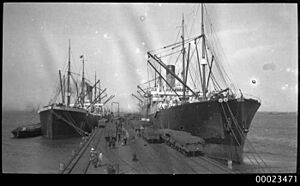
White Star started by serving Australia, especially during the gold rushes of the 1850s. But after the company's first collapse, it focused on the Atlantic. However, in the late 1890s, White Star decided to restart its service to Australia. This was because more gold was found in Western Australia. Also, there was a growing trade in minerals, farm products, wool, and meat. New refrigeration systems allowed ships to carry large amounts of meat back to Britain.
Thomas Ismay decided to re-enter the Australian route in 1897. It would be a monthly service between Liverpool, Cape Town, and Sydney. The trip took six weeks, so five ships were needed. The new ships were called the Jubilee class class. They were the largest ships ever on the Australia route, at 550 feet long and nearly 12,000 tons.
These ships were designed to carry both cargo and passengers. They were slower than mail ships but could carry 320 passengers in what was called third-class. However, White Star's third-class facilities were much better than other lines. Passengers had a dining room, library, and smoking room. They could also use almost all the ship's deck space. The ships could carry 15,000 tons of cargo, including a lot of refrigerated meat.
The first Jubilee-class ship, Afric, started its first trip in February 1899 to New York. The Australian service officially began with the second ship, Medic, in August 1899. The last two ships, Runic and Suevic, were built with a slightly changed design. They had more space for passengers, carrying 400 people.
The Australian route was successful and profitable. During the Boer War, the first three ships carried soldiers and supplies to South Africa. The Suevic ran aground in 1907 but was repaired and returned to service. White Star also used an older cargo ship, the Cevic, on the Australia route seasonally.
Continued demand led White Star to build a special ship for the route, the Ceramic. Launched in 1913, it was larger and more advanced than the Jubilee class. It was 655 feet long and 18,495 tons. The Ceramic was a triple-screw ship, making it slightly faster while using little extra coal. It could carry 600 passengers, still in third-class, but with very good facilities. It also had huge cargo holds, including refrigerated space.
All seven ships were used as troop transports during World War I. White Star had to stop its regular Australian service. The Afric was torpedoed in 1917. The Cevic stayed with the Royal Fleet Auxiliary. But the other five ships returned to White Star, and the service restarted in 1919.
The remaining Jubilee-class liners were retired in the late 1920s. They were converted into whaling factory ships. The Australian route was not as busy or profitable after the war. A new ship, Vedic, launched in 1917, was smaller but also carried immigrants and cargo. The Ceramic and Vedic kept the Australian service going until White Star merged with Cunard in 1934. The new company decided to end White Star's routes to the southern hemisphere. The Ceramic was sold, and the Vedic was scrapped.
The New Zealand Service
In 1883, White Star made a deal with the Shaw, Savill & Albion Line (SS&A) to run a joint service between London and Wellington, New Zealand. White Star had already thought about a New Zealand route. Joining with SS&A, which was already established, seemed like a good idea. Two ships, the Ionic (1883) and the Doric, were already being built.
The White Star/Shaw Savill New Zealand service truly began the next year. White Star provided the crews, and the ships kept their White Star names and look. The route went eastward around the world. Ships stopped at places like Tenerife, Cape Town, and Dar es Salaam on the way to Wellington. Then they rounded Cape Horn and stopped at Montevideo and Rio de Janeiro on the way back.
Traffic on the New Zealand route did not grow as fast as expected. In 1893, a new, larger ship, the Gothic, was introduced. The Coptic and Doric were lent to White Star's partner in the Pacific.
By the next decade, the New Zealand service became more popular and profitable. When White Star joined the International Mercantile Marine Company in 1902, they agreed with SS&A that White Star would build three new ships for the joint service. These were the Athenic class class, about 12,300 tons. They looked like the modified Jubilee-class ships. Unlike the Jubilees, the Athenic class carried passengers in all three classes. The Athenic and Corinthic started service in 1902. The Ionic (1902) (reusing the name of an earlier ship) followed in 1903.
All three ships became troop carriers during World War I. They carried the New Zealand Expeditionary Force to Europe. After the war, they returned to the joint service. But the route was not as busy or profitable anymore. White Star was focusing more on its main Atlantic service.
In 1928, the Athenic was sold and turned into a whaling factory ship. In 1929, the Corinthic was refitted for only third/tourist class passengers. It was sold for scrap in 1931. Only the Ionic was still in service when White Star and Cunard merged in 1934. The Ionic was then sold to Shaw, Savill & Albion. The old liner was scrapped in 1936.
White Star Line Today
The main offices of the White Star Line still stand in Liverpool. They are on James Street, near the grand Cunard Building. A plaque on the building shows that it was once White Star's head office. It was the first open-plan office building in Liverpool. J. Bruce Ismay had his office there.
The White Star Line's London office building, Oceanic House, is also still there. It has been turned into apartments. It is on Cockspur Street, near Trafalgar Square. You can still see the company name over the entrances. The Southampton offices, now called Canute Chambers, also still exist.
The French passenger tender Nomadic is the last surviving White Star vessel. It was bought by the Northern Ireland government in 2006. It has been brought back to Belfast. It has been fully restored to look like it did in 1912. The Nomadic is now an exhibit at the Titanic Belfast museum. This museum tells the story of Atlantic steamships, the White Star Line, and its most famous ship, the Titanic. The Nomadic opened to the public on May 31, 2013.
In 1995, Cunard Line started using "White Star Service" on its ships. This refers to the high standards of customer service expected from the company. The term is still used today on ships like Queen Mary 2 and Queen Elizabeth. Cunard has also created the White Star Academy. This program trains new crew members to meet Cunard's service standards.
The White Star flag is raised on all Cunard ships and the Nomadic every April 15. This is done in memory of the Titanic disaster.
See also
- List of White Star Line ships


